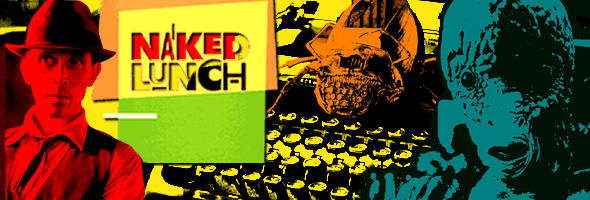
Color, 1991, 115m.
Directed by David Cronenberg
Starring Peter Weller, Judy Davis, Roy Scheider, Julian Sands, Ian Holm
Criterion (Blu-Ray & DVD) US RA/R1 HD/NTSC) / WS (1.78:1) (16:9) / DD2.0, Video/Film Express (Holland R2 PAL) / WS (1.85:1) / DD5.1, GCHTV (France R2 PAL), Asmik (Denmark R2 PAL, Japan R2 NTSC) / WS (1.78:1) (16:9) / DD5.1
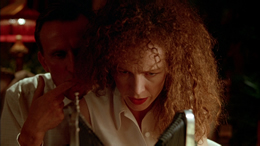 When he first adapted another writer's work in 1983, Stephen King's The Dead Zone, David Cronenberg was accused by more than a few baffled fans of watering down his distinctive vision in service of Hollywood conventions. However, few lobbied this claim against Cronenberg again when he tackled another book, William S. Burroughs' Naked Lunch, and produced one of the mor
When he first adapted another writer's work in 1983, Stephen King's The Dead Zone, David Cronenberg was accused by more than a few baffled fans of watering down his distinctive vision in service of Hollywood conventions. However, few lobbied this claim against Cronenberg again when he tackled another book, William S. Burroughs' Naked Lunch, and produced one of the mor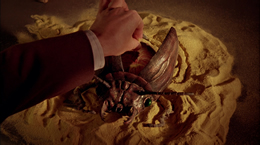 e baffling, incendiary studio films of the 1990s. A compatriot of such beat icons as Jack Kerouac and Allen Ginsberg, Burroughs earned some degree of notoriety by shooting his wife in the head during a William Tell-inspired stunt, only to become a counterculture icon until his death in 1997. Since his explicit, free-associative Naked Lunch resists adaptation in the traditional sense, Cronenberg solved the problem by integrating elements of the novel into Burroughs' life and other writings, producing a work representative of both men's philosophies.
e baffling, incendiary studio films of the 1990s. A compatriot of such beat icons as Jack Kerouac and Allen Ginsberg, Burroughs earned some degree of notoriety by shooting his wife in the head during a William Tell-inspired stunt, only to become a counterculture icon until his death in 1997. Since his explicit, free-associative Naked Lunch resists adaptation in the traditional sense, Cronenberg solved the problem by integrating elements of the novel into Burroughs' life and other writings, producing a work representative of both men's philosophies.
Exterminator and former addict Bill Lee (Weller) lives with his not-always-faithful wife, Joan (Davis), who has a nasty jones for the bug powder her husband uses on the job. Equipped with breath capable of felling cockroaches on the spot, she draws Bill back into a world of addiction and squalor which climaxes with the aforementioned bullet accidentally fired into her head. As Bill's dependence on the bug powder increases, his ability to discern between reality and illusion crumbles. His typewriter becomes a twitching, metallic insect, and he receives information from visiting roach-like beings who lure him into the Interzone, a Middle Eastern realm populated by such odd characters as icy Tom Frost (Holm) and the peculiar Yves Cloquet (Julian Sands), who has a penchant for young men. Bill's chemical dependence is further aided by the smiling but shifty Dr. Benway (Scheider), whose role in the Interzone may be more significant than Bill initially realizes.
Initially received with a mixture of con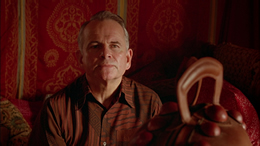 fusion and condescension, this challenging, uncompromising film's reputation has grown considerably over the past two decades or so thanks to Cronenberg's growing filmography, which places it in a much firmer context. Followed by the likes of Crash, eXistenZ, and Cosmopolis, this is the obvious blueprint for the next phase in the director's career following the mainstream humanist trilogy of The Dead Zone, The Fly, and Dead Ringers. Here the abrasive relationship between flesh and metal, soul and technology, becomes much more symbiotic, offering a complex and sensual depiction of modern evolution (hinted at in the rejected ending of Videodrome but only developed here years later).
fusion and condescension, this challenging, uncompromising film's reputation has grown considerably over the past two decades or so thanks to Cronenberg's growing filmography, which places it in a much firmer context. Followed by the likes of Crash, eXistenZ, and Cosmopolis, this is the obvious blueprint for the next phase in the director's career following the mainstream humanist trilogy of The Dead Zone, The Fly, and Dead Ringers. Here the abrasive relationship between flesh and metal, soul and technology, becomes much more symbiotic, offering a complex and sensual depiction of modern evolution (hinted at in the rejected ending of Videodrome but only developed here years later).
For Cronenberg newcomers, this film is hardly the place to start; it's a deliberately difficult, off-putting film on first viewing, with multiple layers of meaning depending on one's perspective. It's a story of artistic inspiration, battling with personal demons, succumbing to the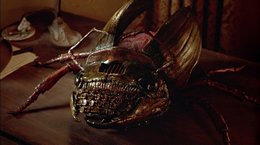 alluring addictions plaguing everyday life, and of course, very strange creatures engaging in grotesque behavior. As usual Howard Shore accentuates the visuals with a sly, intricate jazz score, memorably introduced during the stylish opening credits. The actors are all top notch, with seasoned pros Davis and Holm walking off with all of their scenes; Weller has the more difficult task of playing a Burroughs surrogate while remaining a solid identification figure throughout the film, and his ability to convey yearning, confusion, and despair with a simple glance serves Cronenberg well.
alluring addictions plaguing everyday life, and of course, very strange creatures engaging in grotesque behavior. As usual Howard Shore accentuates the visuals with a sly, intricate jazz score, memorably introduced during the stylish opening credits. The actors are all top notch, with seasoned pros Davis and Holm walking off with all of their scenes; Weller has the more difficult task of playing a Burroughs surrogate while remaining a solid identification figure throughout the film, and his ability to convey yearning, confusion, and despair with a simple glance serves Cronenberg well.
Though Naked Lunch is one of Cronenberg's more visually rich achievements, most of Fox's sparsely distributed prints were poorly struck and failed to convey much of the burnished color schemes. The DVDs actually fared better, with Criterion and the pricier Japanese option presenting the best of the lot thanks to a sterling anamorphic presentation. The Criterion 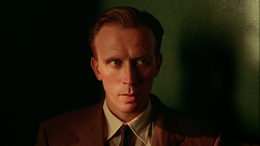 disc features the original surround audio, while the Japanese and Dutch editions have a retooled, shaky 5.1 mix with fake split surround effects. As far as extras, completists may want all of the available variants, but the Criterion contains the most thorough and financially sensible alternative. The more slimmed-down Japanese and French discs feature a Cronenberg commentary, the TV special, and trailer (with the better-looking French set spread over two platters); while the other European discs include only the trailer and an 8-minute video interview with Cronenberg.
disc features the original surround audio, while the Japanese and Dutch editions have a retooled, shaky 5.1 mix with fake split surround effects. As far as extras, completists may want all of the available variants, but the Criterion contains the most thorough and financially sensible alternative. The more slimmed-down Japanese and French discs feature a Cronenberg commentary, the TV special, and trailer (with the better-looking French set spread over two platters); while the other European discs include only the trailer and an 8-minute video interview with Cronenberg.
Those Criterion extras are also present on the best home video option to date, their 2013 Blu-Ray that easily surpasses its predecessors. The NTSC standard is notoriously ill-equipped to handle delicate shades of red and brown, both of which are present here in abundance, and the Blu-Ray unveils layers of detail imperceptible in previous editions on both the small and large screens. Again the 2.0 surround track is presented here (DTS-HD) and sounds great. Cronenberg and Weller appear for an excellent commentary track, which covers the various stylistic choices, the sources used for the screenplay (including Burroughs' "Exterminator"), a solid rebuttal to common criticism about Cronenberg's treatment of Burroughs' homosexuality, and extensive discussion of the symbolism used throughout the protagonist's journey.
On the video front, the biggest coup here is the South Bank Show special, "Naked Making Lunch" by Chris Rodley. Featuring on-location footage and interviews with all of the principals, this 48-minute chronicle is essential viewing for Cronenberg fans and considerable insight into the elaborate process of bringing Burroughs to the screen. Other goodies include an annex of promotional material including the striking theatrical trailer (featuring a Burroughs sound-alike as narrator), an illustrated essay about the special effects by Jody Duncan, a stills gallery, excerpts of Burroughs reading the original source novel (bumped up with HD visual accompaniment here), and a black-and-white gallery of Burroughs photos by the legendary Allen Ginsberg from various points in his life. The obligatory thick insert booklet also contains observations from Janet Maslin, Rodley, Gary Indiana, and a piece by Burroughs himself written shortly before the film's release and discussing his thoughts on the adaptation process. As the writer himself notes near the beginning, "Isn't life peculiar?"
Updated review on April 9, 2013.



 When he first adapted another writer's work in 1983, Stephen King's The Dead Zone, David Cronenberg was accused by more than a few baffled fans of watering down his distinctive vision in service of Hollywood conventions. However, few lobbied this claim against Cronenberg again when he tackled another book, William S. Burroughs' Naked Lunch, and produced one of the mor
When he first adapted another writer's work in 1983, Stephen King's The Dead Zone, David Cronenberg was accused by more than a few baffled fans of watering down his distinctive vision in service of Hollywood conventions. However, few lobbied this claim against Cronenberg again when he tackled another book, William S. Burroughs' Naked Lunch, and produced one of the mor e baffling, incendiary studio films of the 1990s. A compatriot of such beat icons as Jack Kerouac and Allen Ginsberg, Burroughs earned some degree of notoriety by shooting his wife in the head during a William Tell-inspired stunt, only to become a counterculture icon until his death in 1997. Since his explicit, free-associative Naked Lunch resists adaptation in the traditional sense, Cronenberg solved the problem by integrating elements of the novel into Burroughs' life and other writings, producing a work representative of both men's philosophies.
e baffling, incendiary studio films of the 1990s. A compatriot of such beat icons as Jack Kerouac and Allen Ginsberg, Burroughs earned some degree of notoriety by shooting his wife in the head during a William Tell-inspired stunt, only to become a counterculture icon until his death in 1997. Since his explicit, free-associative Naked Lunch resists adaptation in the traditional sense, Cronenberg solved the problem by integrating elements of the novel into Burroughs' life and other writings, producing a work representative of both men's philosophies.  fusion and condescension, this challenging, uncompromising film's reputation has grown considerably over the past two decades or so thanks to Cronenberg's growing filmography, which places it in a much firmer context. Followed by the likes of Crash, eXistenZ, and Cosmopolis, this is the obvious blueprint for the next phase in the director's career following the mainstream humanist trilogy of The Dead Zone, The Fly, and Dead Ringers. Here the abrasive relationship between flesh and metal, soul and technology, becomes much more symbiotic, offering a complex and sensual depiction of modern evolution (hinted at in the rejected ending of Videodrome but only developed here years later).
fusion and condescension, this challenging, uncompromising film's reputation has grown considerably over the past two decades or so thanks to Cronenberg's growing filmography, which places it in a much firmer context. Followed by the likes of Crash, eXistenZ, and Cosmopolis, this is the obvious blueprint for the next phase in the director's career following the mainstream humanist trilogy of The Dead Zone, The Fly, and Dead Ringers. Here the abrasive relationship between flesh and metal, soul and technology, becomes much more symbiotic, offering a complex and sensual depiction of modern evolution (hinted at in the rejected ending of Videodrome but only developed here years later).  alluring addictions plaguing everyday life, and of course, very strange creatures engaging in grotesque behavior. As usual Howard Shore accentuates the visuals with a sly, intricate jazz score, memorably introduced during the stylish opening credits. The actors are all top notch, with seasoned pros Davis and Holm walking off with all of their scenes; Weller has the more difficult task of playing a Burroughs surrogate while remaining a solid identification figure throughout the film, and his ability to convey yearning, confusion, and despair with a simple glance serves Cronenberg well.
alluring addictions plaguing everyday life, and of course, very strange creatures engaging in grotesque behavior. As usual Howard Shore accentuates the visuals with a sly, intricate jazz score, memorably introduced during the stylish opening credits. The actors are all top notch, with seasoned pros Davis and Holm walking off with all of their scenes; Weller has the more difficult task of playing a Burroughs surrogate while remaining a solid identification figure throughout the film, and his ability to convey yearning, confusion, and despair with a simple glance serves Cronenberg well.  disc features the original surround audio, while the Japanese and Dutch editions have a retooled, shaky 5.1 mix with fake split surround effects. As far as extras, completists may want all of the available variants, but the Criterion contains the most thorough and financially sensible alternative. The more slimmed-down Japanese and French discs feature a Cronenberg commentary, the TV special, and trailer (with the better-looking French set spread over two platters); while the other European discs include only the trailer and an 8-minute video interview with Cronenberg.
disc features the original surround audio, while the Japanese and Dutch editions have a retooled, shaky 5.1 mix with fake split surround effects. As far as extras, completists may want all of the available variants, but the Criterion contains the most thorough and financially sensible alternative. The more slimmed-down Japanese and French discs feature a Cronenberg commentary, the TV special, and trailer (with the better-looking French set spread over two platters); while the other European discs include only the trailer and an 8-minute video interview with Cronenberg. ![]()